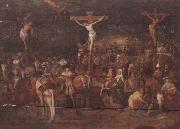
Oil On
Canvas, Real Flavor of Old Masters
|
Agnolo Gaddi
|
|||
|
|
|||
| Italian Early Renaissance Painter, ca.1345-1396 Son of Taddeo Gaddi. Through both his brother Giovanni and his father, Agnolo was heir to the Giottesque tradition and to a successful family enterprise, which he directed with enormous success up to the turn of the 15th century. He is first mentioned as a painter in 1369, when he assisted his brother Giovanni and Giovanni da Milano in decorations for Urban V (reg 1362-70) in the Vatican. Although he probably did not assume full responsibility for the workshop until his brother Giovanni death, he must have begun accepting his own commissions as early as the 1370s. The nature of his early work and whether it included an altarpiece dated 1375 (Parma, G.N., 435), however, remains a matter of debate. Logical or likely though it may be, the notion that this early activity developed out of his brother Giovanni still little-known art is hypothetical. Whereas the works grouped around Giovanni name are all small panels, Agnolo was an artist who, like his father, excelled in wall painting. Indeed, three monumental fresco cycles (see below), in the Castellani Chapel (painted c. 1384) and the choir (painted c. 1388-93) of Santa Croce, Florence, and the chapel of the Sacra Cintola (doc. 1393-5) in Prato Cathedral, constitute the artist most notable surviving works and offer a basis for reconstructing the content and chronology of his oeuvre. | |||
|
|
|||
|
|
The Crucifixion Agnolo Gaddi1.jpg Painting ID:: 1293 Visit European Gallery |
1390-96 Galleria degli Uffizi, Florence | |
Height Width |
INS/CM |
||
|
X |
|
||
|
|
|||
|
Berswordt Altar
|
|||
|
|
|||
| German Gothic Era Painter, active ca.1400] | |||
|
|
|||
|
|
The Crucifixion Berswordt Altar1.jpg Painting ID:: 10760 Visit European Gallery |
1400, tempera and gold on wood transferred to canvas, Metropolitan Museum of Art, New York | |
Height Width |
INS/CM |
||
|
X |
|
||
|
|
|||
|
Palmezzano, Marco
|
|||
|
|
|||
| Italian, Approx. 1459-1539 .Italian painter. His earliest work was probably on the fresco decoration (c. 1480-84) of the vault of the sacristy of the treasury in the Santa Casa, Loreto, designed by Melozzo da Forl?. He then probably went to Rome, where he may have painted the fresco in the apse of Santa Croce in Gerusalemme (Longhi). In 1493 Palmezzano is documented working with Melozzo on the fresco decoration in the Feo Chapel, | |||
|
|
|||
|
|
The Crucifixion new5/Palmezzano, Marco-676757.jpg Painting ID:: 19750 Visit European Gallery |
Tempera on panel Galleria degli Uffizi, Florence. | |
Height Width |
INS/CM |
||
|
X |
|
||
|
|
|||
|
unknow artist
|
|||
|
|
|||
|
|
|||
|
|
The crucifixion new3/unknow artist-965333.jpg Painting ID:: 27434 Visit European Gallery |
mk56 oil on panel,the reverse stamped with the brand of the Antwerp panelmaker s Guild,and a panel maker s mark | |
Height Width |
INS/CM |
||
|
X |
|
||
|
|
|||










